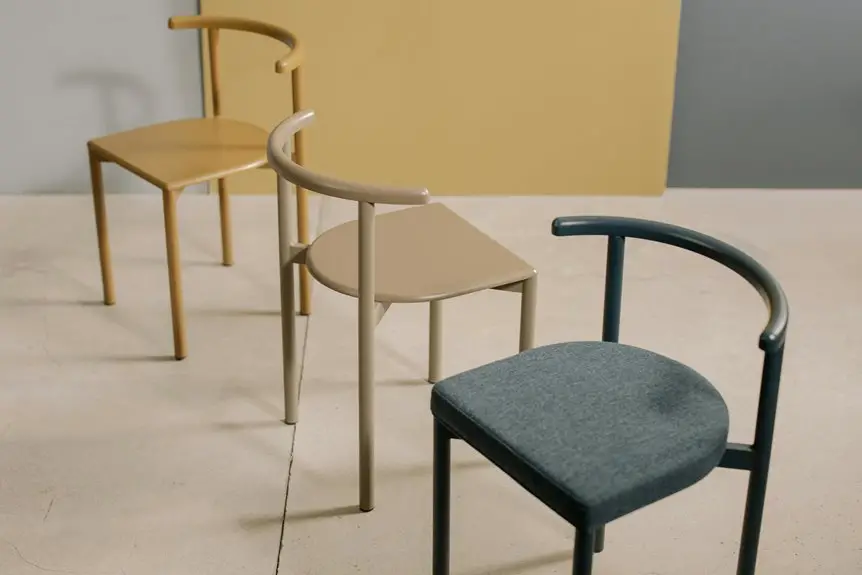Choosing the right colors for your office decor can enhance your mood and productivity. Use calming blues for focus, and energizing yellows or oranges to spark creativity. Greens bring balance and refreshment, reducing stress. Combine these with neutral shades for a harmonious backdrop. Don't forget to test how colors change with lighting; it can make a big difference. Stick around to explore more tips on creating an inviting workspace that boosts your performance.
Table of Contents
Key Takeaways
- Select calming colors like blue for focus areas to enhance concentration and productivity.
- Incorporate yellow accents to stimulate creativity and uplift the overall mood of the workspace.
- Use green to create a balanced environment, reducing stress and fatigue during long projects.
- Start with neutral colors as a base, and add vibrant shades for dynamic and inviting decor.
- Test paint samples in different lighting to ensure colors evoke the desired emotional response.
Understanding Color Psychology
Color psychology plays a crucial role in how we perceive our work environment. Different colors evoke distinct emotions and reactions, shaping your mood and mindset.
For instance, blue often promotes calmness and focus, making it ideal for areas requiring concentration. Yellow, on the other hand, sparks creativity and optimism, which can energize your workspace. Green connects you to nature, helping you feel balanced and refreshed. Red can stimulate energy but may also induce stress if overused.
Understanding these effects empowers you to choose colors that align with your goals and the atmosphere you want to create. By intentionally selecting hues, you can enhance not only your workspace aesthetics but also your overall experience at work.
The Impact of Colors on Productivity
While you may not realize it, the colors surrounding you can significantly influence your productivity levels. Certain hues can evoke emotions and shape your work habits. For example, warm colors can energize you, while cool colors may promote calmness.
Here's a quick overview of how different colors impact your productivity:
| Color | Effect | Best Uses |
|---|---|---|
| Red | Increases energy | Creative tasks |
| Blue | Enhances focus | Analytical work |
| Yellow | Boosts optimism | Brainstorming sessions |
| Green | Reduces fatigue | Long-term projects |
| Orange | Encourages collaboration | Team meetings |
Best Colors for Focus and Concentration
To maintain focus and concentration in your workspace, selecting the right colors is key. Blue stands out as an excellent choice; it's known to promote calmness and clarity, helping you stay focused on tasks without distraction.
Green, with its refreshing vibe, can create a balanced environment, reducing stress while enhancing your ability to concentrate. Neutral colors like gray or beige offer a subtle backdrop, allowing you to maintain a clear mind without overwhelming your senses.
If you prefer a bit of vibrancy, consider soft yellows—they can uplift your mood and stimulate mental activity without being too harsh.
Colors That Stimulate Creativity
When you're looking to spark creativity in your workspace, certain colors can ignite your imagination and inspire innovative thinking. Bright hues like yellow are known to stimulate optimism and encourage brainstorming.
If you want to add energy, consider a vibrant orange. This color can evoke enthusiasm and help you collaborate more effectively.
Blue, while often associated with calmness, can also foster creativity by promoting clear communication and thoughtful expression.
Green, reminiscent of nature, can refresh your mind and encourage new ideas.
Don't shy away from bold accents or playful combinations; they can create a dynamic atmosphere that invites experimentation.
Creating a Calming Environment With Color
When you think about your office decor, consider how color can influence your mood and productivity.
Understanding color psychology can help you choose shades that promote calmness and focus.
Let's explore some of the best calming colors to create a serene workspace.
Color Psychology Basics
Creating a calming environment with color can significantly enhance your workspace and boost productivity. Understanding color psychology is key to this process. Different colors evoke various emotions and can influence your mood, energy level, and focus.
For instance, soft blues and greens often promote tranquility and reduce stress, making them perfect for a serene office atmosphere. On the other hand, warm tones like yellows and oranges can inspire creativity but may also lead to overstimulation if overused.
It's essential to consider how colors interact with natural light and other elements in your space. By thoughtfully selecting colors that align with your goals, you'll create an office that not only looks good but feels good too.
Best Calming Colors
Selecting the right calming colors for your office can transform your workspace into a soothing retreat.
By incorporating these calming hues, you can create an environment that promotes focus and relaxation.
Here are some of the best calming colors to consider:
- Soft Blue: Evokes tranquility and helps reduce stress.
- Pale Green: Connects you to nature, fostering a sense of balance.
- Lavender: Provides a gentle, calming effect, ideal for creativity.
- Light Gray: Offers a neutral backdrop that can enhance concentration.
Combining Colors for a Balanced Workspace
While it might seem daunting to choose the right colors for your office, combining hues effectively can create a balanced workspace that enhances productivity and mood.
Start by selecting a primary color that resonates with you and fits your office's purpose. Then, choose a complementary color to add depth and contrast. For instance, if you pick a soothing blue, consider pairing it with a warm yellow to create energy and vibrancy.
Use neutral colors as a backdrop to ground the space, allowing your chosen colors to shine without overwhelming the senses.
Remember to limit your palette to three or four colors to maintain harmony, ensuring your workspace feels cohesive and inviting.
Tips for Choosing the Right Color Palette
When you're choosing a color palette for your office, it's essential to consider both your personal preferences and the emotional impact of each color.
A well-thought-out palette can enhance productivity, creativity, and overall well-being. Here are some tips to help you select the right colors:
- Understand Color Psychology: Research how different colors affect mood and energy levels.
- Start with Neutrals: Use neutral colors as a base to create a balanced and calming environment.
- Accent with Bold Colors: Add pops of vibrant colors to stimulate creativity and focus.
- Test Samples: Paint swatches on your walls to see how colors look in different lighting throughout the day.
Frequently Asked Questions
How Can I Test Colors Before Painting My Office?
You can test colors by painting small sections on your wall or using color swatches. Move them around to see how they look at different times of day. This way, you'll find what truly fits your space.
Are There Colors to Avoid in a Corporate Office?
In a corporate office, avoid overly bold or dark colors like bright red or deep black. They can create tension or a gloomy atmosphere. Instead, opt for calming shades that promote productivity and collaboration.
How Often Should I Change My Office Colors?
You should consider changing your office colors every few years to keep the environment fresh and inspiring. If you notice fading or wear, it's a good time to rejuvenate your space with new hues.
Can I Use Wallpaper Instead of Paint for Office Decor?
Absolutely, you can use wallpaper instead of paint for your office decor. It adds texture and personality, and with so many designs available, you'll find something that suits your style perfectly. Just make sure it's professional!
What Are Some Budget-Friendly Ways to Incorporate Color?
You can incorporate color on a budget by using accessories like throw pillows, art prints, or desk organizers. Try DIY projects like painted furniture or colorful bulletin boards to brighten your space without breaking the bank.




